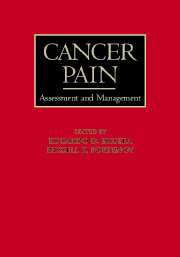Book contents
- Frontmatter
- Contents
- List of contributors
- Preface
- SECTION I MECHANISMS AND EPIDEMIOLOGY
- 1 Nociception: basic principles
- 2 Cancer pain epidemiology: a systematic review
- 3 Cancer pain: prevalence and undertreatment
- SECTION II ASSESSMENT AND SYNDROMES
- SECTION III PHARMACOLOGICAL TREATMENT
- SECTION IV NONPHARMACOLOGICAL APPROACHES
- SECTION V THE ROLE OF ANTINEOPLASTIC THERAPIES IN PAIN CONTROL
- SECTION VI PAIN IN SPECIAL POPULATIONS
- SECTION VII DIFFICULT PAIN PROBLEMS
- SECTION VIII SPECIAL TOPICS
- Index
3 - Cancer pain: prevalence and undertreatment
from SECTION I - MECHANISMS AND EPIDEMIOLOGY
Published online by Cambridge University Press: 08 October 2009
- Frontmatter
- Contents
- List of contributors
- Preface
- SECTION I MECHANISMS AND EPIDEMIOLOGY
- 1 Nociception: basic principles
- 2 Cancer pain epidemiology: a systematic review
- 3 Cancer pain: prevalence and undertreatment
- SECTION II ASSESSMENT AND SYNDROMES
- SECTION III PHARMACOLOGICAL TREATMENT
- SECTION IV NONPHARMACOLOGICAL APPROACHES
- SECTION V THE ROLE OF ANTINEOPLASTIC THERAPIES IN PAIN CONTROL
- SECTION VI PAIN IN SPECIAL POPULATIONS
- SECTION VII DIFFICULT PAIN PROBLEMS
- SECTION VIII SPECIAL TOPICS
- Index
Summary
Introduction
Today, for every death caused by cancer there are two caused by infection and parasitic infestation. It is projected that this number will reach parity by 2015. Most of this increase will occur in the developing world, where 55%–60% of the world's cancer patients reside, and the majority of patients will present for palliation until primary prevention programs are in place. Palliative care is not available to eight out of nine cancer patients in the developing world (1).
Cancer pain affects 17 million people worldwide. Its prevalence increases with extent of disease. Its type, location, and intensity vary with tumor type, spread of disease, and disease treatments (2–6). Prevalence rates of 30%–40% are reported for patients receiving active treatment; these increase to 70% to 90% for patients with advanced cancer (7). The National Hospice Report of 1754 patients with advanced cancer demonstrated that only 25% of patients reported persistent pain within 48 hours of death because only 26% of the patients studied could use the assessment tool included in the study (8). This statistic may exemplify a tendency to underestimate pain prevalence in this group. The unexpectedly low estimates of pain prevalence in this population may relate to the high prevalence of cognitive impairment. Other studies observe pain prevalence rates ranging from 12%–99% in the last week of life, with greater than 30% prevalence in seven of nine studies assessed. This variability may relate to the wide variety of scales used to report pain (9).
Chronic cancer pain may occur in relation to disease progression, a complication of the illness or its treatment, or conditions unrelated to the patient's cancer.
- Type
- Chapter
- Information
- Cancer PainAssessment and Management, pp. 38 - 48Publisher: Cambridge University PressPrint publication year: 2003
- 3
- Cited by



